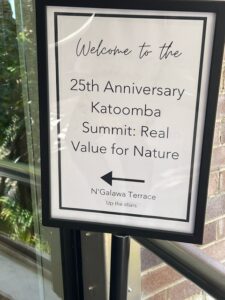How to Make Trees Worth More Standing Than Cut Down
Legal Planet: Environmental Law and Policy 2024-10-14


West of Sydney, Australia, lies the Blue Mountains, a range of plateaus and panoramic canyons forested with eucalyptus trees. Oil in the leaves produces a bluish haze, hence the name of the area. Twenty-five years ago, in 1999, a new NGO called Forest Trends brought together a small international group to the town of Katoomba to brainstorm over increasing capital flows to protect nature, how to “make trees worth more standing than cut down.” The gathering came to be known as the Katoomba Group and continued hosting gatherings around the world, with core and new participants every year. This loose network played a key role in stimulating payment for ecosystem services (PES) programs at both local and national levels, from Peru and Brazil to Switzerland, Japan and many more. Last week, the group returned to Katoomba to celebrate its 25th anniversary and reflect on the past, present, and future of realizing value in nature.
 I became actively involved at the second Katoomba Group event in Tokyo in 1999 and have worked with the legal and institutional aspects of PES ever since. In a series of blog posts, I will be sharing a few particularly interesting insights from the meeting’s three days of discussion.
I became actively involved at the second Katoomba Group event in Tokyo in 1999 and have worked with the legal and institutional aspects of PES ever since. In a series of blog posts, I will be sharing a few particularly interesting insights from the meeting’s three days of discussion.
As quick background, the basic driver for a PES approach is that we need much more funding to conserve natural capital than philanthropy and governments can provide. We all depend on natural capital for our well-being. The need could not be more critical. The last few days have featured headlines of a 73% decline in wildlife over the last 50 years. If you doubt the importance of carbon sequestration, for example, just look at the recent tragedies from storms coming off the Gulf – the 1 in 1,000 year events that climate models predict we should see more and more frequently.
Today’s blog post will focus on nature-based carbon credits.
From the earliest days of climate negotiations, there has been intense interest from the environmental community in the possibility of increased funding for forest protection. In principle, it seems a no-brainer. Forests are important carbon sinks and are being cleared at alarming rates in many areas around the globe. The three great forest basins – the Amazon, the Congo, and Southeast Asia – hold 80% of the world’s tropical forests and 66% of terrestrial biodiversity. Only the Congo, however, is still a net carbon sink. If trading mechanisms allow carbon emissions from one area to be offset by afforestation or reduced rates of deforestation, the climate is better off.
Easy to say. Not so easy to do.
As many readers will know, there have been legitimate concerns over leakage, permanence, and additionality of nature-based carbon credits. Not to mention outright fraud. When John Oliver does an 18-minute take down of offsets on his HBO show, you know there are problems. Nor does it help when Delta Airlines is sued for fraud for its $1 billion commitment to purchase carbon credits so it can achieve carbon neutrality. There was a great deal of discussion at the Katoomba Group meetings about loss of trust.
Does this mean that nature-based carbon credits are fundamentally flawed and should just be rejected? Some respected scholars and environmentalists are of this view. The view of most Katoomba participants, however, was that this would be a mistake. Here are some reasons why.
We are still in the early days of a market.
Any time a new market emerges, there is a good deal of snake oil for sale. When there is an easy way to make a buck, there will be fraud. Over time, however, mechanisms emerge to identify the high-value products and remove the junk. This can happen through stringent government regulation, reputation, private certification, or some combination of these. The LEAF Coalition, for example, is a coalition of over 25 major companies focused on purchasing high-quality forest carbon credits. Control over the entire selection and verification process provides a much greater assurance of quality than relying on third parties. Put simply, we should expect many of the quality problems that have emerged with credits, but these should diminish over time as quality assurance mechanisms develop.
Recognize the Additionality Double Standard.
Most of the criticisms of credits focus on additionality – are we getting value for the money or would the action have happened, anyway? If a company gets credits by paying to conserve a forest on a plot of land, proving additionality requires showing that the forest would likely have been logged absent the payment. If the forest was unlikely to be cut down, this is a waste of money and bogus credits. A well-publicized early carbon credit project, for example, turned out to be for protecting a bird refuge, the last place you’d expect to be logged.
Don’t get me wrong – additionality is genuine concern. But I would argue (and have argued) that we are using a double standard. The fact is that additionality risks arise in many policies throughout government with far more money at stake than with offsets, from Medicare and Low-income Housing Tax Credits to the recently passed Inflation Reduction Act (IRA). The IRA provides a subsidy for purchases of electric vehicles for people making less than $300,000 per year. Would many of these people have bought EV’s, anyway? Probably so, but we don’t denounce the IRA as fatally flawed because of its additionality problems. The key question is how much lack of additionality is acceptable, not whether none exists at all. As above, we should expect less of this problem as the market matures.
Keep your eyes on the prize.
The bottom line is that roughly 99% of carbon emissions are unregulated or not offset at all. And even among those companies that do practice offsetting, total credit purchases make up an average of less than 3% of their overall carbon footprint. The other 97% they’re addressing directly in their operations/value chain. Credits are a tiny part of the picture. Meanwhile, deforestation continues apace and greenhouse gas concentrations continue to rise toward irreversible tipping points. Simply calling for more effective regulation has not been adequate to halt this trend. I see no reason why that will change any time soon. This is a situation of “yes, and…” Regulations matter, but we also need to change the incentives of landowners on the ground.
Credits provide an important mechanism to do so. If the offsets are bogus or not additional, they should not be sold. If they harm local communities, they should not be sold. But I think it’s a mistake to reject categorically a major source of potential funds that can help make trees worth more standing than cut down. We don’t have the luxury of throwing away solutions if they can be improved.
Thus the key question is whether the nature-based credit market can develop over time to minimize these problems so that they become as acceptable as in every other government policy, warts and all. I’m optimistic this can be done, as were most of the Katoomba participants. Trust is hard to build, and easily lost. People are right to be suspicious of offset credits. Suing Delta for fraud, though, strikes me as counterproductive. What signal does that send to other companies trying to take carbon neutrality seriously? I get that this makes sense if you think offset credits are fundamentally flawed. My view is that they can be made genuinely credible, just as we have seen in other emerging markets.
The next blog will focus on corporate disclosure of carbon and natural capital risks.